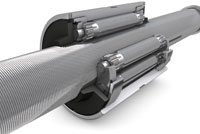
Posted to News on 23rd Nov 2016, 00:00
Power and precision
Where other linear motion technologies don’t fit the bill, roller screws can provide the answer, says Phil Nicholas of SKF.

The modern industrial environment places increasing demands on automation systems. Many processes require high loads to be moved at great speeds and extremely high accuracy. Owners need their machines to work continually for long periods without breaking down, wearing out or demanding frequent preventative maintenance. There is also growing pressure to comply with stringent environmental performance requirements, with minimal energy consumption and clean operation.
If all that wasn’t tricky enough, designers also have less space in which to deliver those capabilities. As plants look to squeeze more value out of costly factory space, cut cycle times and maximise productivity by minimising wasted motion, they need machines that have the smallest possible footprint.
High technology has helped here. Advanced sensors and control devices have pushed machine performance to new levels. But mechanical components matter too, and it’s often these parts of a machine that ultimately determine the limits of its size and performance. The need to push those limits is driving increasing interest in one particular mechanical technology: the roller screw.
Recirculating ball screws have long been the go-to solution for many high precision linear motion applications. In many cases, however, replacing conventional ball screw driven assemblies with roller screws allows size to be reduced and overall performance to be enhanced, in terms of load capacity, positional accuracy, speed and long term reliability.
The planets are aligned
The roller screw was invented by French company La Technique Integral (LTI) in 1949. The company lacked the resources to fully exploit the idea, however, until its purchase by SKF in 1968. Under the brand name Transrol, the new company devel-oped the basic planetary and recirculating designs that underpin all modern roller screws. Like a ball screw, a roller screw uses a rotating externally threaded shaft to control the linear position of an internally threaded ‘nut’. The difference, as the name suggests, is in the design of the elements used to transmit loads while minimising friction and backlash. In the planetary roller screw – the design most commonly used in general industrial applications – a number of threaded rollers sit around the shaft, held in position by guide rings at both ends of the nut. Gear teeth cut into the ends of the rollers mesh with internally toothed rings inside the nut, ensuring the correct rolling motion at all times.
The primary advantage of this design over the ball screw is load carrying capacity. The load carrying capacity of a high efficiency ball or roller screw depends on the surfaces at the points of contact. In ball screws, the load is transmitted from the nut to the shaft through balls engaged in the groove. In a ball screw; the ball diameter is limited to approximately 70% of the screw lead. Hence, the number of contacts is small even if there are multiple starts. In roller screws, by contrast, the load is transmitted from the nut to the screw shaft through the surfaces of all the engaged threaded rollers. The diameter of the contact surface is substantially increased, as is the number of points of contact. That means that for a given size, a roller screw can carry more load, for longer without wearing out.
The recirculating roller screw uses a different design, with grooved rollers that turn independently of the nut within a separate cage. Cams and spaces within the nut are used to reset the position of each roller once per rotation. This design allows the construction of screws with an exceptionally fine lead, and its often used in applications requiring extremely precise movement, like scientific instruments or semiconductor manufacturing.
A third configuration, the inverted roller screw, offers a combination of the benefits the planetary and recirculating designs. In these devices, a set of planetary rollers translates along the inside of the nut during operation, moving a separate push tube that carries the load. The design allows either the nut or the shaft to be driven and inverted roller screws are sometimes built into a motor, creating an exceptionally compact, powerful and accurate short-stroke actuator.
Roller screws have built a reputation for performance and reliability in highly demanding applications. They are widely used in the control of valves for deep sea oil and gas applications, for example, where they will be exposed to extremes of pressure and temperature.
It isn’t just ball screws that are giving way to rollers. The compact size, high power and extreme precision of the roller screw has also seen them replacing hydraulic actuators in a plethora of applications, including plastic injection moulding machines, automotive press tools and powder compaction equipment for the manufacture of carbide machine tool inserts. Racing yachts have replaced hydraulic cylinders with lighter, more reliable roller screws in the mechanisms used to tilt their keels in order to maximise righting moment.
In the Atacama Desert of northern Chile, the European Southern Observatory’s Very Large Telescope uses four 8.2m diameter mirrors to detect astronomical objects billions of times too faint to be seen by the naked eye. Each mirror rests on a bed of 150 SKF recirculating roller screws, which move automatically every 25 seconds to compensate for polishing defects and deformation due to gravity as the mirror is tilted to face different parts of the sky.
To perform optimally, roller screws must be manufactured to great precision, using high quality materials. In SKF roller screws, for example, roller threads are ground to sub-micron precision before undergoing careful heat treatment to optimise the properties of the rolling surfaces. As a result, roller screws tend to cost more that ball or hydraulic actuators. In a growing number of applications, however, that additional investment is repaid many times over, thanks to higher performance, superior reliability and a longer working life.









